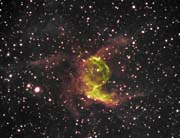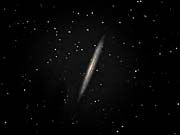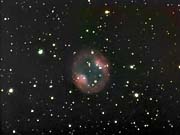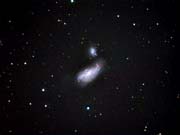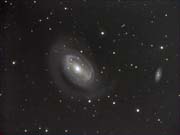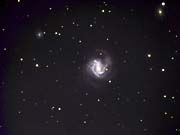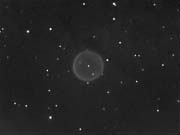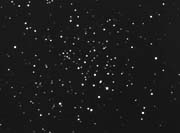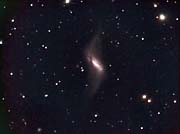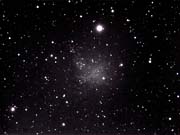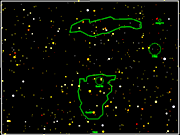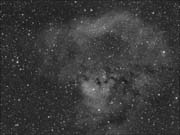For all these images, click on the thumbnail for a medium size
image (normally 800x600) and on the link in each description for the
full size (around1390 x 1040) image.
|
Saturday 17th February 2007 promised to be a beautiful
night, and some friends had booked a cabin at Calvert Trust,
Kielder. So I landed on them complete with my newly acquired
EQ6 Pro mount. The night was a stunner, but earlier on I was
trying to get to grips with the mount. The Witch Head
nebula, NGC 1909 in Eridanus is a faint and difficult
target, and although it reaches an altitude of 27 degrees, I
was trying for it nearer 20. But while I was aligning the
system, I noticed a streak of light on a 21 second test
frame. So took a number of frames with this result. It would
appear that the object was a Geostationary satellite, though
I have been unable to identify it.
|
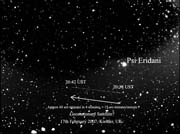
|
|
Then I started imaging in earnest. Unfortunately I was
picking up some low light glow, possibly from cabin or
street lights. Despite being classed as a bright nebula,
illuminated by the nearby bright star Psi Eridani, I found
it necessary to bin the individual frames. Rather
disappointing, maybe I will try again with narrowband
filters. The image is displayed upside down to better show
the 'witch' profile, so the light glow is at the top.
Artemis 285 with 135 mm camera lens, 8 x 8 mins. binned 2x2.
But many years later (2019) at
last!
|
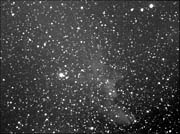
|
|
After the disappointment with the
Witchhead, I went for a much higher target, the trio in Leo
of M65, M66 and NGC 3628. MUCH more satisfying! I was
guiding the EQ6 mount with my long exposure webcam and a 300
mm lens, and this proved very successful at the imaging
focal length of 650 mm on my TMB 105 refractor. The night
was very cold and frosty, and unfortunately started to mist
over before I obtained all the colour information. So
monochrome (for now!) Artemis 285, 12 x 5 minute frames. I
imaged this group
shortly after getting my Artemis in 2005, but this is a
better one!!
Post Script. The night of 20th. March cleared beautifully
after a period of northerly gales and snow showers, and I
was able at last to obtain the colour information at Hexham.
RGB each 4 x 6 minutes.
Full size
|
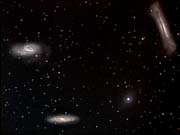
|
|
From time to time I add to my Messier
collection. A few were imaged some time ago and needed
replacing, like the M61 above. Others have never been
tackled, or were part of a larger view, such as M66 in Leo,
previously only captured as part of the 'Leo Trio'. Now on
its own, Luminance 14 x 5 minutes on 8th. April 2007, RGB
each 4 x 5 minutes on 14th. April. Artemis 285 and Mirage 8
at f6.3. Full
Size
|
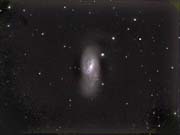
|
|
M63 in Canes Venatici was previously
imaged in April 2005,
but I decided to try for a better image in 2007. Luminance
11 x 5 minutes on 6th. April 2007, RGB each 4 x 5 minutes on
14th. April. The luminance frames were affected by high
haze, so I attempted more luminance frames on 14th. April
but was experiencing some guiding problems. In the end the
final image shows little improvement over the 2005 one.
However, the very first of the 14th. April luminance
frames showed a satellite trail right across the core of the
galaxy. The satellite turned out to be Cosmos 1058, and was
just leaving the Earth's shadow as seen from the brightening
of the trail as it moved from lower right to upper left.
Artemis 285, Mirage 8 at f6.3. These
images appeared in the August 2007 issue of Practical
Astronomer
Full Size
colour
|
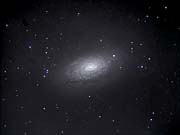 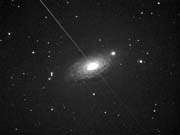
|
|
M98 in Coma Berenices is a new target for
me , and was imaged on the night of 16/17th. April 2007.
Slightly hazy skies and poor seeing, robbing the image of
some detail , nevertheless the spiral structure is clearly
seen. Luminance 12 x 5 minutes, RGB each 4 x 5 minutes,
Artemis 285 and Mirage 8 at f6.3
Full size
|
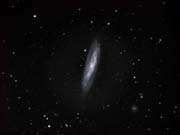
|
|
M99 in Coma Berenices also was due a
first time visit. This galaxy has a smaller apparent size,
so I imaged it at f10. I'd acquired the target following
M98, but the cloud thickened, and I had to abandon the
attempt. But I left the main and guide cameras in their
configuration, so was able quickly to take advantage of a
clear spell the following night (17th). Again haze and poor
seeing affected the quality, but enough data was present to
obtain this image. The 'slower' configuration required
longer exposures, so Luminance was 10 x 8 minute frames.
With the weather deteriorating, to save time RGB data was
captured binned 2x2, each 4 x 4 minutes. Full
size
|
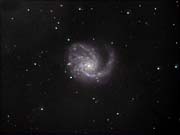
|
Most of May was either moonlit , cloudy or too bright with Summer
twilight.
